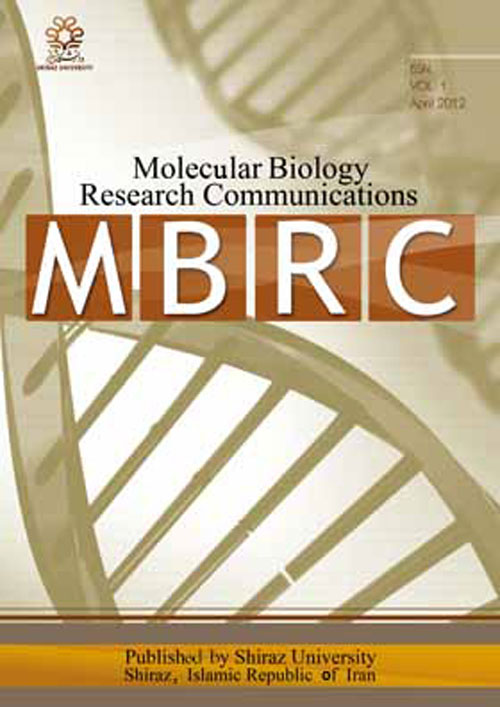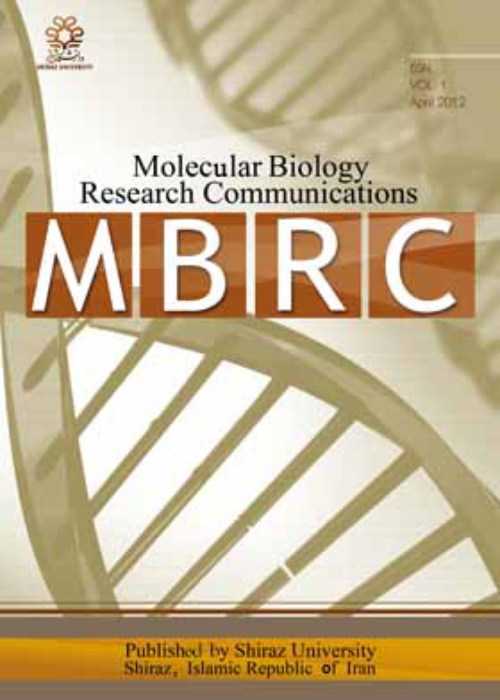فهرست مطالب

Molecular Biology Research Communications
Volume:9 Issue: 2, Jun 2020
- تاریخ انتشار: 1399/04/23
- تعداد عناوین: 6
-
-
Pages 41-43Interleukin-6 (IL6) is encoded by the IL6 gene in human and acts as pro-inflammatory cytokine and an anti-inflammatory cytokine. Recent studies established that IL6 substantially contribute in the diagnosed of systemic inflammation for the patients suffering from lung diseases such as chronic obstructive pulmonary disease (COPD). Thereof, this work aimed to investigate the protagonist of IL6 (-174 G/C) genotypes as an essential risk factor for COPD in north Indian population. In the study, a total of 200 clinically diagnosed patients with COPD were selected against 200 patients. Statistical analysis reveleaed that there was no significant association between the IL6 -174 G/C genetic polymorphism and the risk of COPD (P>0.05).Keywords: Chronic obstructive pulmonary disease, Interleukin-6, Genotypes, cytokine
-
Pages 45-53Studies on earthworms using molecular markers are rare in Africa except a handful from South Africa. Reports on Libyodrilus violaceous,an earthworm found in West Africaare available including their metal tolerance and bioaccumulation capacity but their molecular characterization and ecotoxicology studies are scarce. In this study, triplicate L. violaceous specimens were collected from four locations within a petroleum polluted site and one in a control site, ≃1Km away from point of spill. DNA was extracted and 18S rRNA and 16S rRNA genes were amplified and sequenced. DNA methylation of their 18S rRNA gene was determined using Methylation specific PCR (MSP) method. Phylogenetic trees generated for 18S rRNA and 16S rRNA genes grouped L. violaceous within the Eudrilidae family concurrent with its conventional grouping and MSP results indicate no methylation in L. violaceous population from this site.Keywords: Oil spill, Pollution, Natural attenuation, DNA Barcode, Phylogeny
-
Pages 55-62Paulownia tomentosa (Thunb.) Steud. is a very important hard woody plant, an extremely fast-growing tree and produce timber. Therefore, there is a demand to produce transgenic Paulownia plant resistant to bacterial infection. Microbial infection (especially bacterial one) is serious sever and cause a loss in plant productivity as they bear upon the character and amount of plant product. Two phytopathogenic bacteria were chosen to consider their effect on Paulownia tomentosa. These two bacterial species were Erwinia carotovora and Pseudomonas aeruginosa. Two thionin genes (AT1G12660 and AT1G12663) were selected. They produce antimicrobial peptides to resist this bacterial infection. Chitosan nanoparticle is a novel technology in genetic transformation into plant tissues. Chitosan nanoparticles were used in a ratio of 1:1 with the plasmid DNA carrying thionin genes independently. Characterization for chitosan nanoparticles was applied to determine the conditions of genetic transformation. The new transgenic P. tomentosa lines produced are partially resistant to these two bacterial infections compared to non-transgenic lines. The inhibitory percentage in the transgenic lines ranged from 8 to 21% wherein the non-transgenic the inhibitory percentage of P. tomentosa leaves ranged from 53-24%. Likewise, it is noticed that is Paulownia tomentosa less infectious than Erwinia carotovora. In conclusion, I recommend using chitosan nanoparticle is an excellent way for gene transformation into plant tissues. Also, manipulate the idea of using thionin as antimicrobial genes to resist bacterial infection for different plant species.Keywords: Chitosan nanoparticle, Erwinia carotovora, thionin genes transformation
-
Pages 63-69
Amelogenin gene (AMEL-X) encodes an enamel protein called amelogenin, which plays a vital role in tooth development. Any mutations in this gene or the associated pathway lead to developmental abnormalities of the tooth. The present study aims to analyze functional missense mutations in AMEL-X genes and derive an association with amelogenesis imperfecta. The information on missense mutations of human AMEL-X gene was collected from Ensembl database (https://asia.ensembl.org). Three different computational tools viz., SIFT, PolyPhen and PROVEAN were used to identify the deleterious or pathogenic forms of mutations in the gene studied. I-Mutant Suit was used to identify the stability of the proteins identified as deleterious by the three tools. Further, MutPred analysis revealed the pathogenicity of these mutations. Among 96 missense variants reported in AMEL-X gene, 18 were found to be deleterious using the three prediction tools (SIFT, PolyPhen and PROVEAN). When these variants were subjected to protein stability analysis, about 14 missense variants showed decreased stability whereas the other 8 variants showed increased stability. Further, these variants were analyzed using MutPred which identified 9 variants to be highly pathogenic. ExAC database revealed that all the pathogenic mutations had a minor allele frequency less than 0.01. The in silico analysis revealed highly pathogenic mutations in amelogenin gene which could have a putative association with amelogenesis imperfecta. These mutations should be screened in patients for early diagnosis of susceptibility to AI.
Keywords: Mutation, AMELX gene, Enamel, Amelogenesis imperfecta, In silico -
Pages 71-82Human papillomaviruses (HPV) are a group of strong human carcinogen viruses considered to be the fourth leading cause of mortality among women in the world. HPV is the most important cause of cervical cancer, which is the second most common cancer in women living in low and middle-income countries. To date, there is no effective cure for an ongoing HPV infection; therefore, it is required to investigate anticancer drugs against this life-threatening infection. In this study, we collected more than 100 plant-derivedcompounds with anti-cancer and antiviral potentials from a variety of papers. Smile formats of these compounds (ligand), were harvested from PubChem database and examined based on the absorption, distribution, metabolism, excretion, and toxicity properties by programs such as Swiss ADME, admetSAR, and pkCSM. Twenty compounds, which were likely to be the HPV16E6 inhibitor, were selected for docking calculations. We examined these natural inhibitors against the HPV16 E6 oncogenic protein. Eventually, three of these compounds were used as the most potent inhibitors (Ginkgetin (peculiarly), Hypericin and Apigetrin) were probably used as the possible source of cancer treatment caused by E6 oncoprotein. In this research, we conducted the docking calculations by Autodock 4.2.6 software. Docking analysis showed the interaction of these plant-originated inhibitors with E6AP, p53, and Myc binding sites on the E6 oncoprotein which support the normal function of E6AP, p53, and Myc.Keywords: HPV16 E6, Natural inhibitors, Molecular docking, E6AP, p53, Myc
-
Pages 83-91The current outbreak of severe acute respiratory syndrome coronavirus 2 (SARS-CoV-2)in China threatened humankind worldwide. The coronaviruses contains the largest RNA genome among all other known RNA viruses, therefore the disease etiology can be understood by analyzing the genome sequence of SARS-CoV-2. In this study, we used an ab-intio based computational tool VMir to scan the complete genome of SARS-CoV-2 to predict pre-miRNAs. The potential pre-miRNAs were identified by ViralMir and mature miRNAs were recognized by Mature Bayes. Additionally, predicted mature miRNAs were analysed against human genome by miRDB server to retrieve target genes. Besides that we also retrieved GO (Gene Ontology) terms for pathways, functions and cellular components. We predicted 26 mature miRNAs from genome of SARS-CoV-2 that targets human genes involved in pathways like EGF receptor signaling, apoptosis signaling, VEGF signaling, FGF receptor signaling. Gene enrichment tool analysis and substantial literature evidences suggests role of genes like BMPR2 and p53 in pulmonary vasculature and antiviral innate immunity respectively. Our findings may help research community to understand virus pathogenesis.Keywords: MicroRNA, Coronavirus, target, COVID-19, pathways, gene silencing


